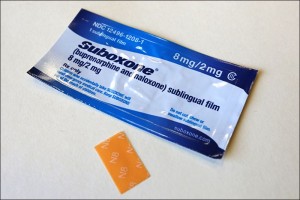Suboxone is a drug used to treat those suffering from opiate addiction. It is a sub-lingual medication, meaning it is taken by allowing it to dissolve under the tongue. You should always take Suboxone exactly as your doctor prescribes. This is the only way to take it and remain safe. Although Suboxone is extremely effective for treating opiate addictions, like many drugs it is not without its hazards. According to the literature provided by Reckitt Benckiser Pharmaceuticals Inc., Suboxone carries significant risks of addiction, overdose, and other issues when taken incorrectly.
Main Ingredients in Suboxone
The main ingredients in Suboxone are buprenorphine and Naloxone. These two drugs work together to give Suboxone its anti-withdrawal properties. Unfortunately, both of these drugs have some severe side effects if not taken correctly.
- Buprenorphine – works as an opiate replacement drug. It is an opiate drug itself and stops the stronger more dangerous opiates from binding to the receptor sites. This stops chronic pain and stops withdrawal symptoms associated with stopping opiates.
- Naloxone – works as an opiate antagonist. This is also the key ingredient in Narcan. It reverses the effects of opiates sending the user into immediate withdrawal. The most common use of Naloxone is to prevent or slow overdose by full reversal of the opiates action on the body.
Both of these actions combined allow a person to continue to recovery from addiction without experiencing withdrawal.
Forms of Suboxone

A common way of administering Suboxone is sublingual film.
Suboxone comes in two primary forms, pill and sublingual film. When you are looking at the dosage information for Suboxone you will see two milligram numbers. The first number is the amount of buprenorphine and the second is the amount of Naloxone.
The pill comes in:
- 8 mg / 2 mg
- 2 mg / 0.5 mg
The sublingual film comes in:
- 8 mg / 2 mg
- 2 mg / 0.5 mg
- 12 mg / 3 mg
- 4 mg / 1mg
The dosage of Naloxone is always less than the dosage of buprenorphine. This allows Suboxone to act as a painkiller as well as an opiate replacement drug.
Doctors are very careful to take the dosage that is nearest your level of addiction or level of pain. They prescribe the sublingual Suboxone more often than pills because not only is it faster acting the dosage is easier to modify. Some doctors might recommend sectioning the film for optimum use.
Side Effects of Suboxone
According to the National Library of Medicine, the side effects of Suboxone are:
- headache,
- stomach pain,
- constipation,
- vomiting,
- insomnia,
- rashes,
- lack of energy,
- loss of appetite,
- sweating,
- yellow eyes or skin,
- slowed breathing,
- extreme fatigue,
- pancreatic pain,
- hives, and
- difficulty swallowing or breathing.
It is impossible to list all of the possible side effects to any drug and Suboxone has many more. If you decide to take Suboxone, it is important to discuss the side effects with your doctor before starting this drug. There are some side effects that indicate a serious problem such as liver damage and pancreatitis.
Dangers of Suboxone
Suboxone is a very powerful drug. Unfortunately, this also means that it has some fairly serious consequences if it is misused.
- Addiction – Suboxone is a form of painkiller there is a chance of addiction to it. This is why it is important to taper off it when you decide to stop taking it.
- Serious side effects – the more Suboxone you take the more serious the side effects are.
- Anaphylactic shock – some people are allergic to an ingredient in Suboxone. This means that they can have a reaction and stop breathing.
- Dependence- because Suboxone doesn’t eliminate opiate addiction, merely replaces it, there is a strong possibility of dependence that would result in withdrawal when stopping Suboxone use.
- Death- the misuse of Suboxone may result in serious bodily damage or death.
There is also evidence that some Suboxone patients do not receive the amount of counseling and continuing care to ensure that their quality of life improves. Since there is a low risk of overdosing on Suboxone, and it will not make a user “high”, some doctors simply prescribe the drug and fail to follow up. This is no guarantee that everyone experiences these issues. It is also important to note that there is very little information about the effects of long-term Suboxone use, as it is a relatively new drug.
Benefits of Suboxone
It would seem, from the side effects and dangers of Suboxone, that taking it is not a good idea. That is simply not the case. According to a pamphlet published by the Substance Abuse and Mental Health Services Administration, there are many benefits to using Suboxone to help treat opiate addiction. Some of these benefits include:
- Decreased withdrawal symptoms,
- Low risk of overdose when taken properly,
- Reduced cravings for opiates,
- Less side effects than methadone,
- It allows the patient to think and function normally,
- It is relatively easy to taper off the dosage, and quit,
- It is manufactured and sold legally, and
- Suboxone helps the patient regain control of their life.
These are not the only benefits of treatment with Suboxone. The fact of the matter is that patients that incorporate Suboxone into an opiate addiction treatment regimen are far more likely to succeed and become drug free.
Knowing how to take Suboxone is only one aspect of the knowledge required to make an informed decision about incorporating it into an opiate treatment protocol. If you or someone you know is considering opiate addiction treatment, call 888-646-0865 (Who Answers?) and talk to one of our counselors, so you can begin the path to recovery today.